
A pine is any conifer tree or shrub in the genus Pinus of the family Pinaceae. Pinus is the sole genus in the subfamily Pinoideae.
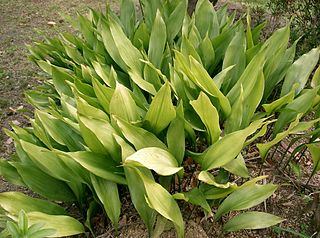
Aspidistra is a genus of flowering plants in the family Asparagaceae, subfamily Nolinoideae, native to eastern and southeastern Asia, particularly China and Vietnam. They grow in shade under trees and shrubs. Their leaves arise more or less directly from ground level, where their flowers also appear. The number of species known has increased considerably from the 1980s onwards, with around 100 accepted as of July 2013. Aspidistra elatior is common worldwide as a foliage house plant that is very tolerant of neglect. It and other species can also be grown in shade outside, where they are generally hardy to −5 °C (23 °F).

The Pinaceae, or pine family, are conifer trees or shrubs, including many of the well-known conifers of commercial importance such as cedars, firs, hemlocks, piñons, larches, pines and spruces. The family is included in the order Pinales, formerly known as Coniferales. Pinaceae have distinctive cones with woody scales bearing typically two ovules, and are supported as monophyletic by both morphological trait and genetic analysis. They are the largest extant conifer family in species diversity, with between 220 and 250 species in 11 genera, and the second-largest in geographical range, found in most of the Northern Hemisphere, with the majority of the species in temperate climates, but ranging from subarctic to tropical. The family often forms the dominant component of boreal, coastal, and montane forests. One species, Pinus merkusii, grows just south of the equator in Southeast Asia. Major centres of diversity are found in the mountains of southwest China, Mexico, central Japan, and California.
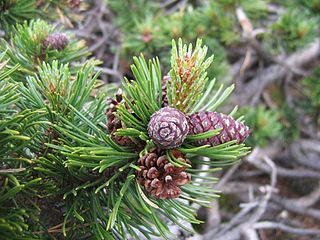
Pinus mugo, known as dwarf mountain pine, mountain pine, scrub mountain pine, Swiss mountain pine, bog pine, creeping pine, or mugo pine, is a species of conifer, native to high elevation habitats from southwestern to Central Europe and Southeast Europe.

Picea abies, the Norway spruce or European spruce, is a species of spruce native to Northern, Central and Eastern Europe.

Pinus ponderosa, commonly known as the ponderosa pine, bull pine, blackjack pine, western yellow-pine, or filipinus pine is a very large pine tree species of variable habitat native to mountainous regions of western North America. It is the most widely distributed pine species in North America.
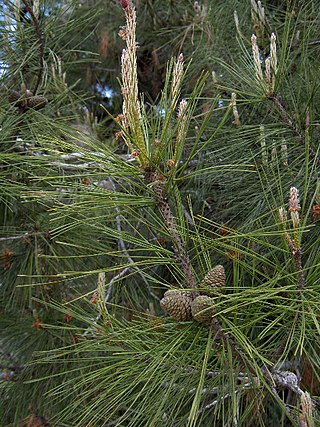
Pinus brutia, commonly known as the Turkish pine and Calabrian pine, is a species of pine native to the eastern Mediterranean region. The bulk of its range is in Turkey, but certain varieties are naturalized as far east as Afghanistan. It is also known as East Mediterranean pine, Afghan pine, and Brutia pine. The name "Calabrian pine" comes from an introduced grove in the Calabria region of southern Italy; historically this region was called Bruttium, which is likely where the specific epithet "brutia" comes from. Pinus brutia bears many similarities with other, closely related species such as Pinus halepensis and Pinus canariensis. Turkish pine forms a species complex with the former.

Pinus ayacahuite, also called ayacahuite pine and Mexican white pine, is a species of pine native to the mountains of southern Mexico and western Central America, in the Sierra Madre del Sur mountains and the eastern end of the Eje Volcánico Transversal, between 14° and 21°N latitude in the Mexican states of Guerrero, Oaxaca, Puebla, Veracruz and Chiapas, and in Guatemala, El Salvador and Honduras. It grows on relatively moist areas with summer rainfalls, however specimens from its eastern and southern distribution live under really wet conditions; it needs full sun and well drained soils. Its temperature needs fluctuate between 19 and 10 °C on average a year. This tree accepts from subtropical to cool climate.
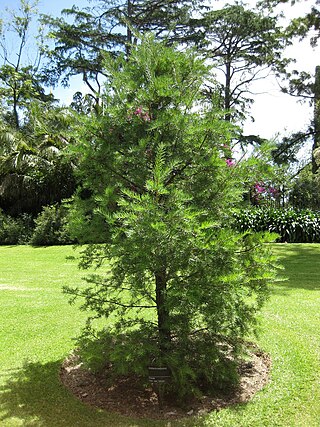
Keteleeria evelyniana is a species of conifer native to southern China, Laos and Vietnam. It can grow to a height of 40 metres (130 ft).
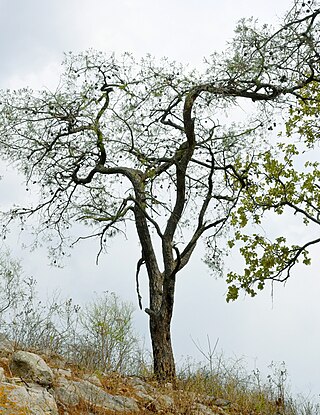
Pinus praetermissa, commonly known as McVaugh's pine, is a species of conifer in the family Pinaceae. Originally classified as a variety of Pinus oocarpa in 1909, it was promoted to specific status in 1990 after further study.

Pinus wangii, commonly known as the Guangdong white pine, is a species of conifer in the family Pinaceae.

Spiranthes cernua, commonly called nodding lady's tresses, or nodding ladies' tresses, is a species of orchid occurring from Maritime Canada to the eastern and southern United States. As the common name suggests cernua means "nodding", or "bowed" in Latin.
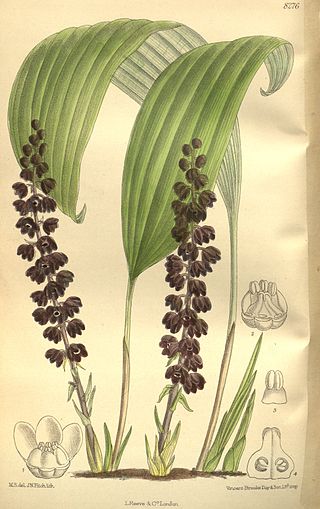
Peliosanthes is a genus of flowering plants found in eastern Asia. In the APG III classification system, it is placed in the family Asparagaceae, subfamily Nolinoideae.
Dipterocarpus dyeri (Khmer: rôyiëng, chhë tiël pruhs, chhë tiël th'nô:r, local name Kompong Thom: chhieutiel chgor, name used for commercial timber and the group of trees harvested for such: keruing, Vietnamese: Dầu Song Nàng, is a species of tree in the family Dipterocarpaceae found in Myanmar, Thailand, Peninsular Malaysia, Cambodia, Vietnam, and northwestern Borneo. The tree is found in rain forest and lowland semi-evergreen dipterocarp forests, an alternative habitat description is mixed dense forests of the plains, mainly among rivers and valleys. The tree is a climax or late successional species, which in some secondary forests forms relatively young pure colonies. The conservation status is based on rates of habitat loss, the major threat to the taxa, though in Vietnam it is cited as having a less threatened conservation status of Vulnerable.
Leptomischus is a genus of plants in the family Rubiaceae, native to southern China and southeast Asia. A 2019 molecular phylogenetic study placed it in the tribe Argostemmateae.

Pinus stylesii is a species of pine in the family Pinaceae, native to the northern Sierra Madre Oriental mountains of northeastern Mexico. A tree reaching 25 m (82 ft), it is a member of Pinus subsection Strobus. It was split off from Pinus strobiformis, which is found in the Sierra Madre Occidental.

Pinus georginae, commonly known as Pino chino, is a species of medium-sized conifer in the family Pinaceae. It was first described by Pérez de la Rosa in 2009, and was named for Georgina Vargas Amado, who was with Pérez de la Rosa at the time of the tree's description. It is in the Pinus subsect. Australes.
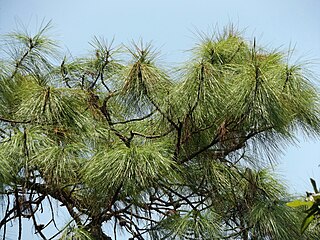
Pinus vallartensis, rarely called the Vallarta pine, is a species of medium-sized conifer in the family Pinaceae. The species was described by Pérez de la Rosa and David S. Gernandt in 2017. It is in the Pinus subsect. Australes.
Pinus leptokrempfii was a species of large-sized conifer in the family Pinaceae. It was an early relative of Pinus krempfii, being present in the Oligocene Period. The extinct species had shorter, narrower needles than Pinus krempfii, which is where the name "leptokrempfii" derived for "lepto" means "short and narrow". The first specimens were described in the Yunnan Province, China, where fossils revealed the noticeable trait of flat needles, like Pinus krempfii. Pinus krempfii evolved to survive in warmer climates, such as northern Vietnam, where it broke off of Pinus leptokrempfii after the Oligocene Period. The fossils of the species were discovered by Jian-Wei Zhang in 2021, and was eventually placed in the Pinus subect. Krempfianae.
Pinus ravii is a rare, semi-disputed species of large-sized conifer in the family Pinaceae.















